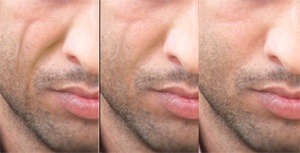Microdroplet Silicone Treatment for Facial Lipoatrophy in HIV

Understanding Facial Lipoatrophy in HIV
Facial lipoatrophy is a condition characterized by the loss of fat from the face, leading to a sunken or hollow appearance. It is commonly associated with HIV and can have a significant impact on self-esteem and quality of life.
Causes of Facial Lipoatrophy in HIV
Facial lipoatrophy in HIV patients is primarily a side effect of antiretroviral therapy, particularly older medications such as stavudine (d4T) and zidovudine (AZT). These drugs can cause changes in fat distribution in the body, leading to the loss of subcutaneous fat in the face. Although newer treatments have reduced the incidence of this condition, those who started therapy with older medications may still experience its effects.
Treatment with Microdroplet Silicone
Microdroplet silicone injections are a minimally invasive treatment option for restoring facial volume and contour. This method involves the injection of medical-grade silicone in tiny amounts (microdroplets) into the affected areas of the face. Over time, this stimulates the body's natural collagen production, gradually enhancing facial volume and improving appearance.
Off-label Use of Silicone
It's important to note that the use of silicone microdroplets for treating facial lipoatrophy is considered an off-label use. Silicone is FDA-approved for certain medical applications, such as intraocular lenses and other specific medical devices, but not specifically for facial fillers. However, it has been used by experienced physicians for facial augmentation due to its long-lasting effects.
What to Expect During Treatment
- Consultation: During your initial consultation, Dr. Barry Resnik will evaluate your facial structure and discuss your treatment goals.
- Procedure: The procedure involves a series of small injections using a fine needle. It is typically performed in the office and may require multiple sessions to achieve the desired results.
- Recovery: Most patients experience minimal downtime. You may notice some redness or swelling at the injection sites, which usually resolves within a few days.
Potential Temporary Complications
Temporary complications may include, but are not limited to, bruising, bleeding, local swelling, tenderness, numbness, irritation in the area of injection, and granuloma formation. These side effects are generally mild and resolve over time, but it's important to discuss any concerns with Dr. Resnik.
Benefits of Microdroplet Silicone
- Long-lasting Results: Unlike temporary fillers, microdroplet silicone offers a more permanent solution for facial lipoatrophy.
- Natural Appearance: The gradual increase in collagen production helps achieve a natural, youthful look.
- Minimal Downtime: Patients can return to their normal activities shortly after the procedure.
Considerations
- Safety: Microdroplet silicone has been used safely for many years; however, it's important to have the procedure performed by an experienced and qualified physician.
- Follow-up: Regular follow-up appointments will be scheduled to monitor your progress and make any necessary adjustments.
